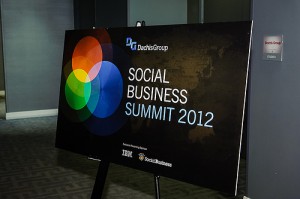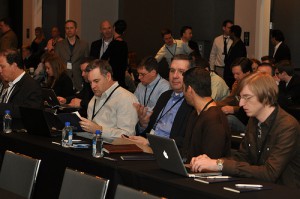BY SUSAN LAHEY
Reporter with Silicon Hills News

Photo courtesy of the Dachis Group.
When the lights went out at the Super Bowl, Oreo scored a social media touchdown by Tweeting out: “You can even dunk in the dark.”
It was spoken of at the
2013 Social Business Summit the way “Think Different” and “Just Do It” were spoken of in advertising circles. It was a stroke of brilliance, a visit from the social media muse. It generated the kind of attention every business wants from its social media but no one knows how to create. The Oreo Tweet, however, came in second after the Old Spice social media campaign which garnered more than 40 million views. In that campaign, the Old Spice Guy made 186 video responses to fans and blasted them out over social media channels.
The campaign doubled sales of the body wash, bringing it to number one. And nearly every speaker at the day-long Social Business Summit referenced it….with slides.
Photos courtesy of Dachis Group.[/caption]These are the social media Camelot stories that drew 200 people to the W Hotel Thursday. The Dachis Group of Austin put on the summit. Later this year, they’ll hold Social Business Summits in Shanghai, Mumbai, London, Sao Paulo, Tokyo and New York.
At the Austin event, the question before speakers was how one takes a constantly changing medium with more than 400 outlets, each having millions of disparate constituents, and weaves that into an ongoing business plan. They used the term “Perfect Storm” a lot.

Photo courtesy of the Dachis Group
Many speakers focused on the numbers–how much social media could increase sales and customer satisfaction; how wide is the window to jump in on a trending story; the precise equation for the half-life of a social media buzz. But it was the second-to-last speaker who addressed the manic and often ill-advised effort to constantly be in customers’ faces with social media, having no clear objective in mind.
Olivier Blanchard, author of Social Media R.O.I. asked the poignant question—and made the audience repeat it with him twice—“What the fuck are we doing?”
The reason to have a social media campaign, he said, the reason to track customer behavior and engage customers in conversation, is to become a better company.
“We should be focusing on building better products, creating better customer experiences, eliminating hurdles and pain points for customers, converting our audience to customers, driving loyalty,” he said. Social media should be part of sales and PR, community involvement and business intelligence. And a huge part of customer service. Better to have a team dedicated to responding to negative Tweets about the company in real time than to have a call center, he said.
Blanchard was only one of several speakers to insist that social media could no longer be the baby of the marketing department but had to be integrated throughout the organization. Employees must get involved with the company’s social media presence—a suggestion that unfortunately brought up several unanswered and tricky legal questions regarding employee policies and freedom of speech.
Blanchard and others also suggested that any company serious about social media needs a mission control center where staffers are watching Twitter for mentions of the company, engaging in conversations in real time over every social media channel they’re involved with, and watching news for relevant topics to comment on to connect with constituents.
All of this needs to be incorporated into a content process with a content strategy and a staff to write copy, edit it and post it, according to Michael Brito of Edelman Digital. Companies need to become media businesses, which means they need quality content, based on stories of customers and vendors, trends and news, and–only marginally–marketing information. Companies need an institutional process for generating and distributing that content.
Timing of social media was discussed at length. Dr. Scott Henderson, Principal Data Scientist of Gnip, said that for certain purposes, such as product development and brand management, engagement should go deep and be on a slower clock than, say responding to a trending event. Public relations and supply chain issues should be responded to quickly and concisely. Customer service should include deep engagement but should happen almost instantly. The window for responding to a trending story was often only a few hours.
Brian Solis, Principal of Altimeter Group, said studies show that responding to customers in five minutes rather than 24 hours results in seven times more sales. Customers, he said, don’t want to surf websites on their phones. They want “snackable” information in real time, such as reviews.
The real advantage social media has over static content such as websites, he said, is the opportunity to respond in the moment a customer is having an experience, resulting in shared experiences. Shared experiences are the future of branding because they are the only way to be flexible to the changing nature of humans, what he called the “human algorithm.”
John Hagel, Co-Chairman of Deloitte LLP Center for the Edge spoke of quite a different kind of human algorithm. His group is charged for looking beyond what companies are doing now to technologies and practices they might adopt in the future. Many of those technologies track human behavior and performance. One study, for example, looked at performance behaviors of people playing World of Warcraft and tracking their own weaknesses and opportunities for improved performance. Similar techniques, he said, might be employed in the workplace.
Another tracking study involved an app being piloted in San Francisco that tracks a user’s behavior over time and identifies patterns. From that pattern, it can identify a tribe of people with similar patterns. Once a tribe is identified, the app can recommend restaurants or other businesses frequented by members of the tribe.
“Ultimately it can become a trusted advisor,” Hagel said.
One of the metrics the Center for the Edge studied through concentrated data collection was the optimal performance one could achieve in a team related to the team dynamics. There was a delicate balance, he said, citing two different studies, between a team being so interconnected that it wasn’t outward reaching enough to perform well and a team being sufficiently connected that they shared personal as well as professional parts of their lives. In that balance, he said, was tacit company knowledge exchanged.
New technologies, Hagel said “are creating mounting performance pressure on all of us. This isn’t just a cyclical problem and there will not be a downturn in a few years. The pressure has been mounting for decades and there’s absolutely no sign of it leveling off. Performance matters and you have to be able to tie it back to metrics—financial metrics, operating metrics, front line metrics.”
While Hagel’s presentation seemed to reduce human behavior to a stream of data, the speaker who followed him, Zappos founder and CEO Tony Hsieh had an almost diametrically opposed perspective on human interaction. In fact, it was pointed out that he never spoke once about social media or in his entire presentation.
“Social media is a bad word for us,” he confessed. (Though the Zappos Facebook site has 476,000 users.)
Hsieh explained that he was happy to sell his first company, LinkExchange, to Microsoft, partly because the culture was so unhappy. After he and co-founders had hired all their friends, they had no means by which to choose good employees outside their social circles.
When he founded Zappos, the company’s culture was paramount. Since the company has moved outside Las Vegas, Nevada, many of the company’s employees live in the same apartment complex and socialize regularly. They are reinvigorating a little-known, community-oriented part of downtown Las Vegas (read, no gambling or glitz). And Hsieh has purchased the former Las Vegas city hall to get all employees under one roof. He thinks now in terms not of density but of “collisionable hours” or hours of the day during which time people have to run into one another in the walkable community he’s trying to establish for Zappos.
When asked what he thought about Yahoo’s Marissa Mayer insisting on employees all occupying a space and whether that was a good idea, Hsieh said it depended on whether they all liked each other. Building a culture where people like each other is key to the whole Zappos concept.
If there was one takeaway from the conference as a whole it would have to be that, while data tracking and engagement building are a function of a social media strategy, what differentiates a business with a social media strategy versus a social media business is having a business whose goals are aligned with the customers, partners and associates they’re engaging with.
For most businesses, that remains the elusive Holy Grail.
![]() The pitch was: Move your company to Austin for free. Five companies in other parts of the country or the world competed for a $100,000 package that included:
The pitch was: Move your company to Austin for free. Five companies in other parts of the country or the world competed for a $100,000 package that included:
